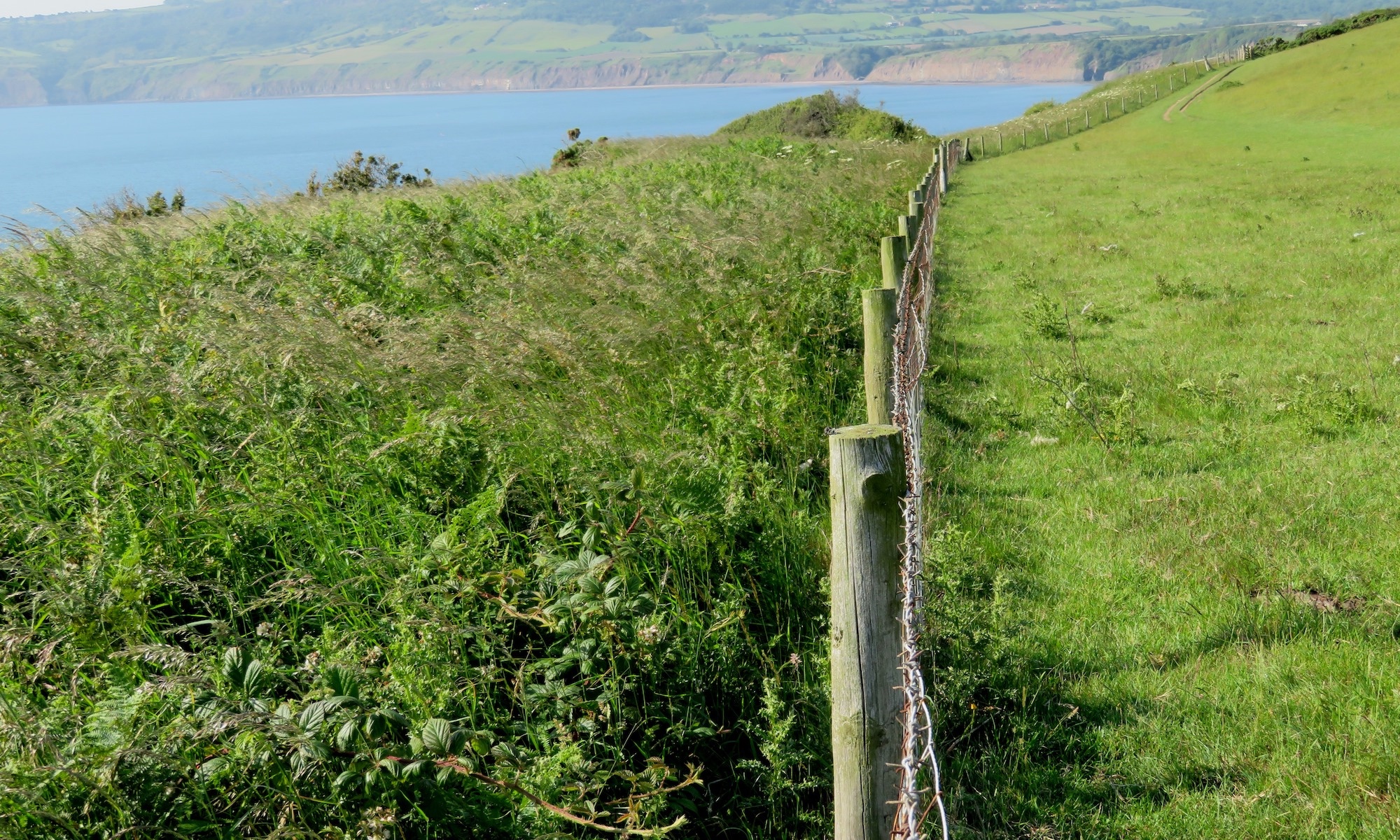Celebrating the summer solstice with a YRN site visit to a smallholding near Holmfirth, West Yorkshire.
by George Valentine
29th June 2024
“Follow the farm track between the bins…”. Hidden away in an unassuming housing estate in Meltham is the entrance to a rather more exciting world, one which you might easily miss. Like the twenty or so other people who ventured down the farm track, I was keen to visit this ‘traditional hay meadow’ which is part of a 40-acre smallholding in Kirklees.
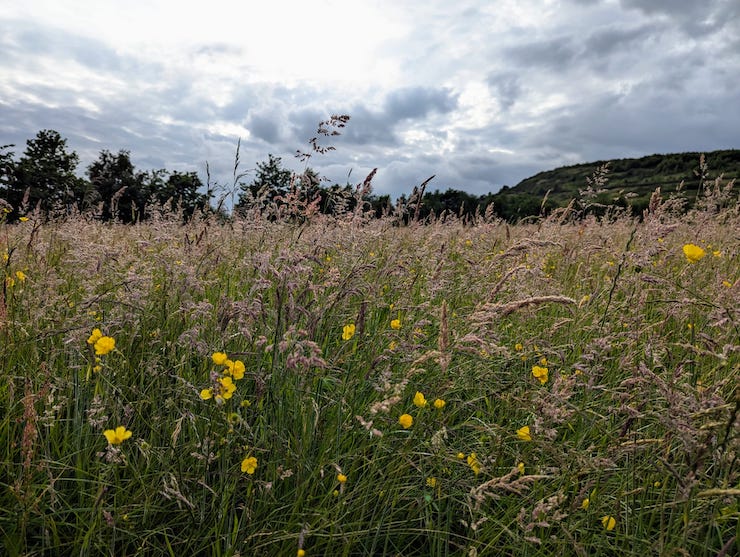
Rewarded for our journey, we were greeted by Ruth Patterson, the owner and custodian, and a generous table of tea and home baking. As a Forest School Practitioner, Ruth introduces young people to the joys of being immersed in nature (and the huge benefits this brings). This complements her passion for the land and for encouraging it too to flourish… with an abundance of different ecological niches. Ruth explained that the land has been in her family for the last 40 years, a mere blink of the eye, according to the deeds which go back not far short of 400 years. It’s likely that the hay meadow has a long history and during her family’s time has never been sprayed or fertilised. The delicate balance of nutrient poor soil and once yearly harvesting which is so vital for the 40 species of wildflower that are found here has managed to survive. A recent grassland fungi survey also identified some species of rare fungi that only exist in this now very rare habitat. Most wildflower meadows in Britain have been swallowed up in the race of ever-expanding agricultural business.
With ample warning about the boggy and uneven ground we set off on a guided tour and soon discovered it was as described! Passing through the hay meadow we stopped to admire the meadow buttercups, different from their creeping cousins which populate urban gardens. With relish, Ruth described the scent of the newly cut hay, so different from the ‘mildly offensive’ smell of today’s silage. Traditional hay meadows are rich in biodiversity, cut only once a year, ‘always waiting as long as possible after the second week in July’ so that the flowering is over, and seeds have set. In contrast, silage (used to feed overwintering cattle) may be cut several times in one season, hence flowering plants rarely get the chance to set seed or diversify. The abundance of flowers in a traditional hay meadow supports a rich insect life and small mammals at the base of the food chain can proliferate, sheltering and finding cover in the tall grasses. We stopped to admire the shiny blue-black wings of an alder beetle on a nearby tree. Ruth pointed out a shelter belt of trees planted four years ago, each intervention on this piece of land is an invitation for nature to reciprocate in its own way, a two-way conversation between humans and nature.
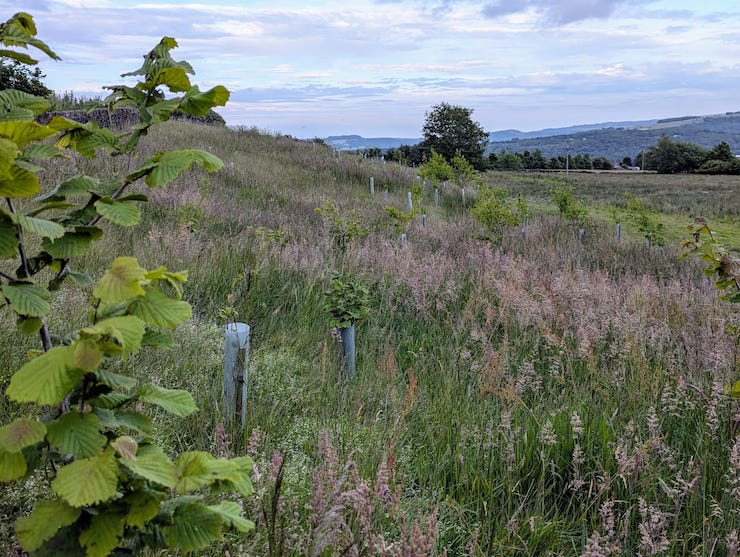
Helping each other to climb over a farm gate we entered a boggy area filled with sedge, marsh thistles and common rushes. The land drains which were introduced in the Victorian era have now been blocked off to allow this area to revert to its earlier boggy state. A ten-foot-deep pond has been dug, the clay soil being sufficient to hold the water. We picked our way through an abundance of shoulder high vegetation including rosebay willow herb, blackthorn and willow alder (most of which is self seeded) to reach the edge of the water. Taking care not to fall in we adults had a chance to revert back to our childhood selves using long handled pond dipping nets to scoop up whatever treasures were lurking beneath the broad-leaved pond weed and deposit them in the awaiting water troughs. Tadpoles, baby froglets, damselfly nymphs and all manner of water beetles and invertebrates twitched and wriggled as we tried to identify them from the handy booklets provided. This rich environment now attracts dragonflies, damsel flies, newts, and herons. Even an oyster catcher has been seen. Ruth explained how the creation of the pond has already had an effect on the surrounding area which is slightly less boggy than it was and now has areas of brambles. When we see a snapshot of a landscape it’s good to remember that what looks fixed is actually a dynamic process, each intervention triggering an ecological effect and creating a whole new niche for different life forms to interact in.
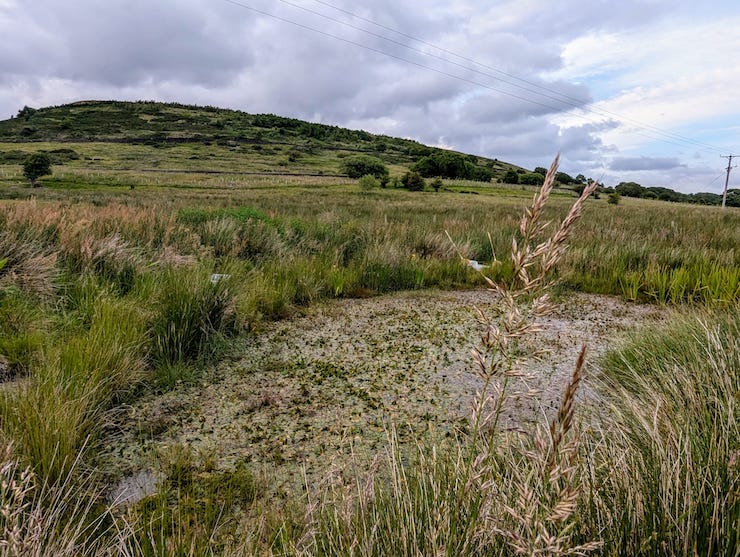
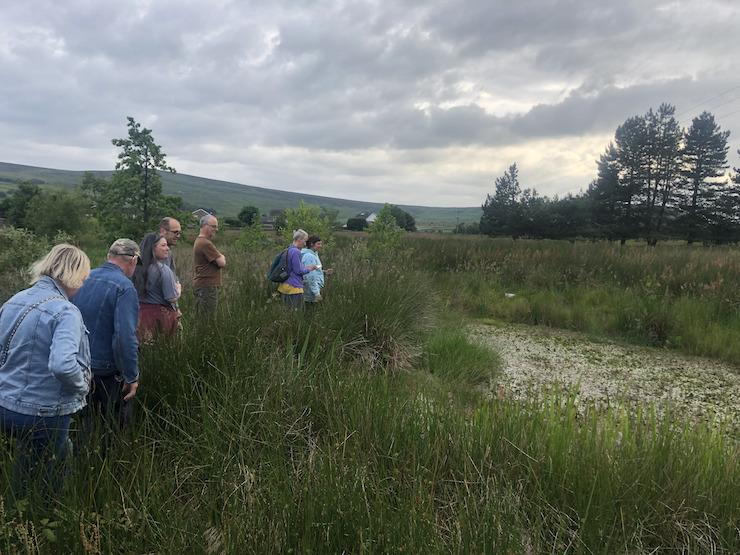
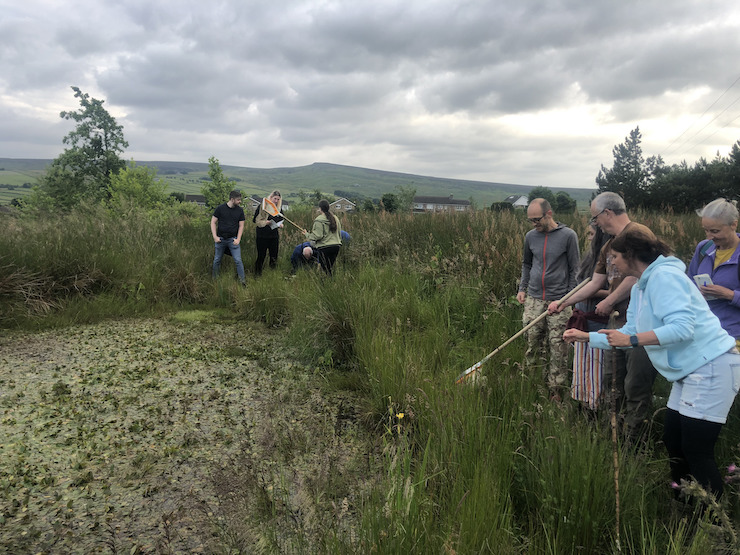
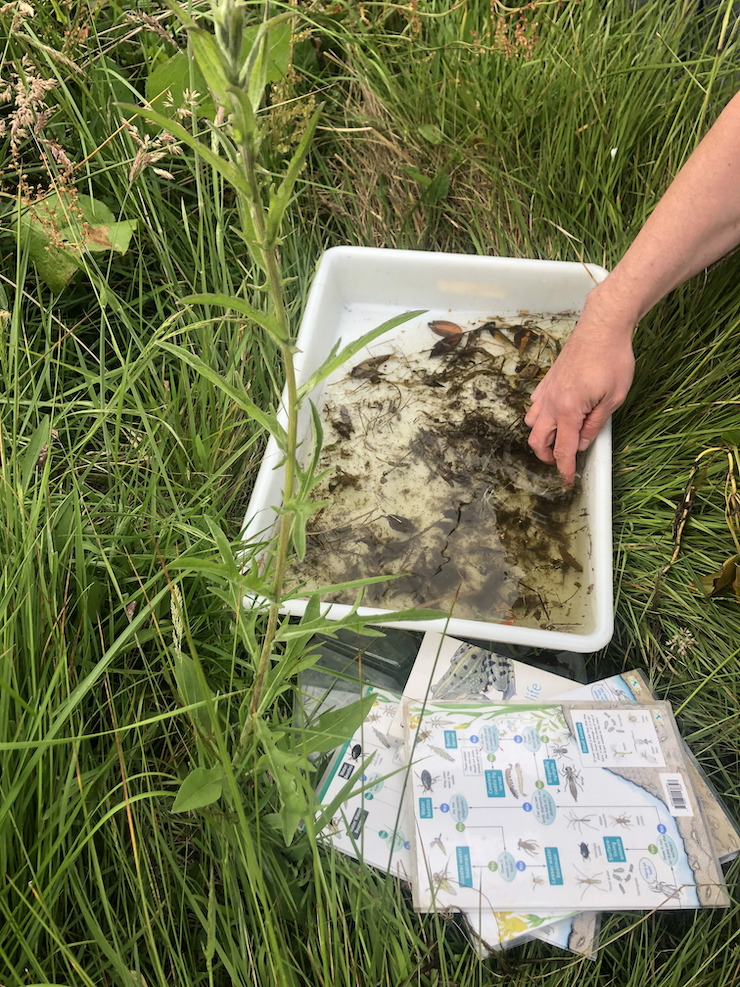
From here we headed towards a row of mature Scots Pines, planted as a wind break near an area which used to be part of ‘Holme Valley Isolation Hospital’ in the 1800s. The hospital has now gone, but all that remains is an old water tank and an area now grazed by five ‘miniature’ highland cattle, complete with shaggy coats and rather impressive horns. As they gazed over towards the spectacle of 20 unfamiliar humans I wondered what the full size species would be like to encounter and was rather glad I was in a group. These animals are here in small numbers to perform what could be called ‘conservation grazing’. Their browsing and trampling habits (when in low numbers) create additional ecological niches and keep some pastureland open, preventing it from eventually returning to woodland. We noticed tiny yellow Tormentil flowers and the white haze of heath bedstraw growing in the naturally acidic grassland.
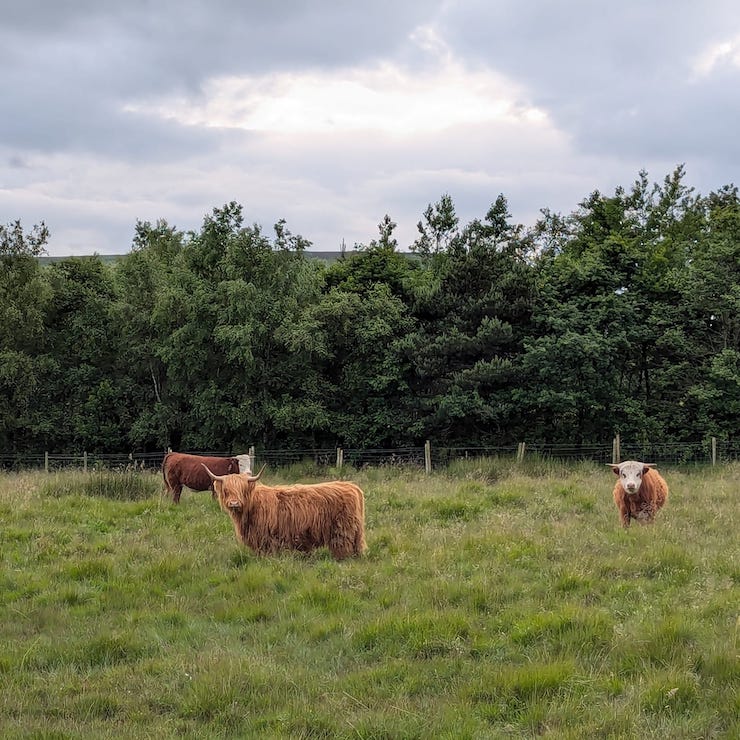
We approached another shelter belt of deciduous trees which is now fifteen years old. The protective fence has been removed so that the cattle can browse and rub themselves underneath the trees, sometimes breaking branches and creating dead wood habitat and an ‘understory’ of new growth. The cows had also managed to knock a camera trap off one of the trees, but the cameras have been useful to see if any other creatures are drawn to the safety of woodland and scrub at the edge of these fields.
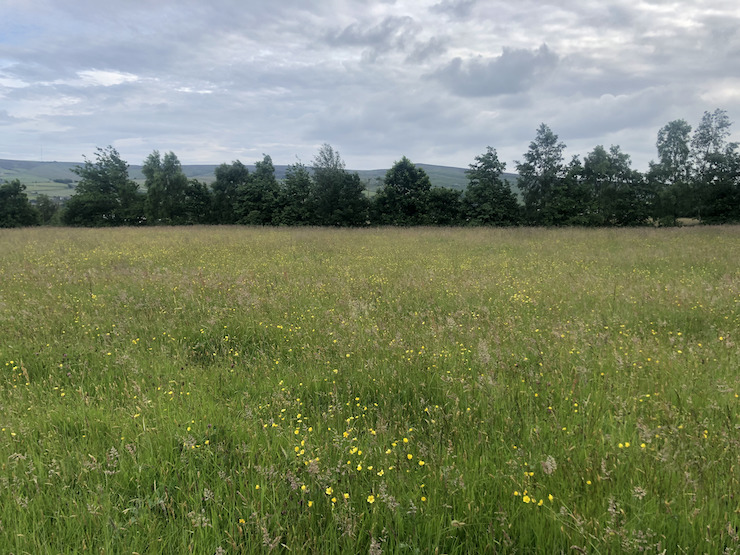
I was interested to learn that the dry-stone walls round many of the fields here do actually support wildlife, becoming a home for spiders, mice, stoats and weasels. The adjacent land has been allowed to diversify much more than the average farm field and that will also be a factor in these walls becoming a home for so many insects and small mammals.
Our next adventure was climbing the wall up onto ‘The Catch’ (otherwise known as Blackmoorfoot Conduit) constructed in the 1870s to channel water from above Marsden into the reservoir. The channel is a bit like a man-made shallow river, the banks of which over time had become a wonderful haven for wildlife with self-seeded trees and areas of rushes and river plants. We heard how a recent landslip had restricted the water flow and how the water company responsible had ripped out all the trees as part of their ‘improvements’ to re-establish the flow. Where water voles had once thrived is now a patch of bare concrete. Amongst our group were two members of River Holme Connections, a local charity, and they are exploring the possibility of trying to get water voles back into the valley. These small herbivores burrow into riverbanks and thrive in wet habitats with plenty of cover. They are classified as endangered species in England due to habitat loss and predation by introduced, non-native American mink.
As we walked alongside the waterway we could see Honley Old Wood, an ancient woodland on the other side of the valley. Closer to home we could admire the interweaving of newly planted trees, scrub, bog (including a small area of peat bog), wildflower meadows and areas of woodland in various stages of maturity. Ruth pointed out a barn owl box positioned high up the trunk of a large sycamore, protected by its canopy, but with an open flight path in. She described the distinct hissing sound of the baby barn owls and how one year there were so many fledglings that the parents were simply too busy to be bothered by human onlookers. We learned how barn owl numbers seriously declined due to lack of suitable nesting places, and how their numbers have begun to recover now that more people are installing nesting boxes. We wished the same thing could happen for swallows. A shortage of suitable housing it seems is not only a human problem.
As we headed back towards the farmhouse we passed a magnificent oak tree, its gnarled and bulbous trunk may have seen 500 years. From behind the trunk three equally magnificent equine heads emerged and watched us pass by with curiosity, their black shaggy ankles, proud necks and strong stature hinted at a Dales pony or maybe a Friesian… what great neighbours to have.
As we approached the house, we admired an abundant patch of purple wood vetch and chatted about the value of ‘scrub’ and ‘messy’ habitat, neither pasture, nor woodland but that vital place which knits together different landscapes and supports so many species… soldier beetles, latticed heath moth, yellow shell moth, redstarts, stonechats, little owls… all have made their homes in this wonderfully varied habitat.
The sound of happy voices and the feeling of like-minded company accompanied me to the door of my car. By now the evening light was gracing the longest day of the year, infusing the sky and hills with that magical light. I am so glad to have spent the summer solstice in this way.
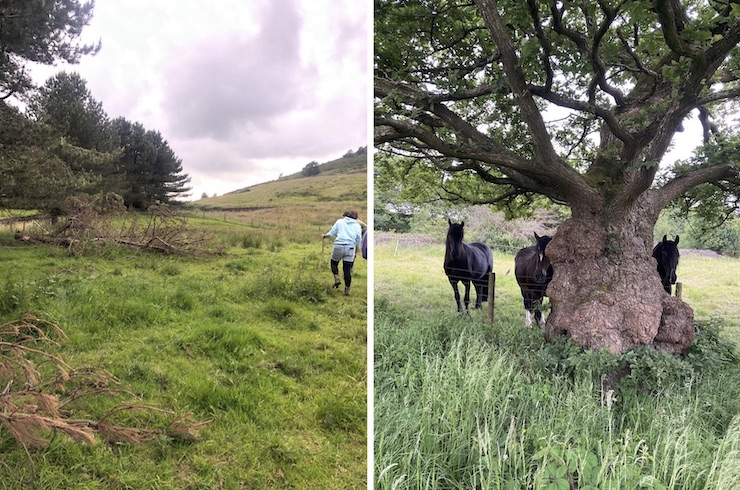
Thank you to Ruth Patterson who generously hosted this site visit as part of the Yorkshire Rewilding Network summer site visit programme – a series of events giving people a chance to see rewilding in action, meet others and be inspired.
More information:
[Images: Tom Jepson, Evan Jeffries, George Valentine]
